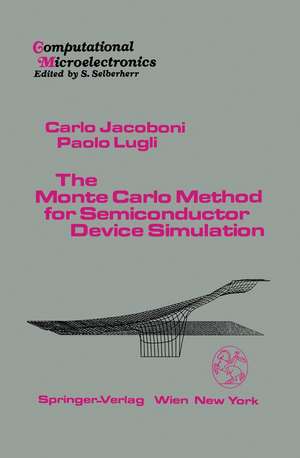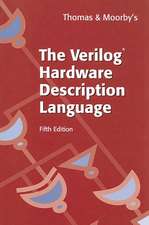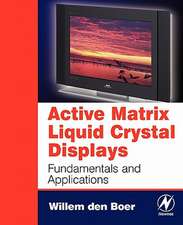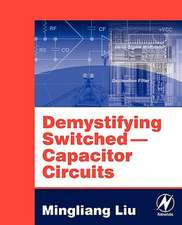The Monte Carlo Method for Semiconductor Device Simulation: Computational Microelectronics
Autor Carlo Jacoboni, Paolo Luglien Limba Engleză Hardback – 30 oct 1989
| Toate formatele și edițiile | Preț | Express |
|---|---|---|
| Paperback (1) | 948.16 lei 6-8 săpt. | |
| SPRINGER VIENNA – 5 oct 2011 | 948.16 lei 6-8 săpt. | |
| Hardback (1) | 954.45 lei 6-8 săpt. | |
| SPRINGER VIENNA – 30 oct 1989 | 954.45 lei 6-8 săpt. |
Din seria Computational Microelectronics
- 18%
 Preț: 944.51 lei
Preț: 944.51 lei - 20%
 Preț: 438.50 lei
Preț: 438.50 lei - 15%
 Preț: 646.11 lei
Preț: 646.11 lei - 18%
 Preț: 951.91 lei
Preț: 951.91 lei - 18%
 Preț: 952.09 lei
Preț: 952.09 lei - 15%
 Preț: 638.11 lei
Preț: 638.11 lei - 15%
 Preț: 642.51 lei
Preț: 642.51 lei - 18%
 Preț: 954.45 lei
Preț: 954.45 lei -
 Preț: 390.08 lei
Preț: 390.08 lei -
 Preț: 386.99 lei
Preț: 386.99 lei -
 Preț: 397.38 lei
Preț: 397.38 lei - 20%
 Preț: 666.40 lei
Preț: 666.40 lei -
 Preț: 392.97 lei
Preț: 392.97 lei - 24%
 Preț: 742.69 lei
Preț: 742.69 lei - 18%
 Preț: 1842.31 lei
Preț: 1842.31 lei - 15%
 Preț: 584.25 lei
Preț: 584.25 lei
Preț: 954.45 lei
Preț vechi: 1163.97 lei
-18% Nou
Puncte Express: 1432
Preț estimativ în valută:
182.64€ • 195.30$ • 152.28£
182.64€ • 195.30$ • 152.28£
Carte tipărită la comandă
Livrare economică 18 aprilie-02 mai
Preluare comenzi: 021 569.72.76
Specificații
ISBN-13: 9783211821107
ISBN-10: 3211821104
Pagini: 376
Ilustrații: X, 359 p.
Dimensiuni: 156 x 234 x 26 mm
Greutate: 0.7 kg
Ediția:1989
Editura: SPRINGER VIENNA
Colecția Springer
Seria Computational Microelectronics
Locul publicării:Vienna, Austria
ISBN-10: 3211821104
Pagini: 376
Ilustrații: X, 359 p.
Dimensiuni: 156 x 234 x 26 mm
Greutate: 0.7 kg
Ediția:1989
Editura: SPRINGER VIENNA
Colecția Springer
Seria Computational Microelectronics
Locul publicării:Vienna, Austria
Public țintă
ResearchCuprins
1 Introduction.- References.- 2 Charge Transport in Semiconductors.- 2.1 Electron Dynamics.- 2.2 Energy Bands.- 2.3 Scattering Mechanisms.- 2.4 Scattering Probabilities.- 2.5 Transport Equation.- 2.6 Linear Response and the Relaxation Time Approximation.- 2.7 Diffusion, Noise, and Velocity Autocorrelation Function.- 2.8 Hot Electrons.- 2.9 Transient Transport.- 2.10 The Two-dimensional Electron Gas.- References.- 3 The Monte Carlo Simulation.- 3.1 Fundamentals.- 3.2 Definition of the Physical System.- 3.3 Initial Conditions.- 3.4 The Free Flight, Self Scattering.- 3.5 The Scattering Process.- 3.6 The Choice of the State After Scattering.- 3.7 Collection of Results for Steady-State Phenomena.- 3.8 The Ensemble Monte Carlo (EMC).- 3.9 Many Particle Effects.- 3.10 Monte Carlo Simulation of the 2DEG.- 3.11 Special Topics.- 3.12 Variance-reducing Techniques.- 3.13 Comparison with Other Techniques.- References.- 4 Review of Semiconductor Devices.- 4.1 Introduction.- 4.2 Historical Evolution of Semiconductor Devices.- 4.3 Physical Basis of Semiconductor Devices.- 4.4 Comparison of Semiconductor Devices.- References.- 5 Monte Carlo Simulation of Semiconductor Devices.- 5.1 Introduction.- 5.2 Geometry of the System.- 5.3 Particle-Mesh Force Calculation.- 5.4 Poisson Solver and Field Distribution.- 5.5 The Monte Carlo Simulation of Semiconductor Devices.- References.- 6 Applications.- 6.1 Introduction.- 6.2 Diodes.- 6.3 MESFET.- 6.4 HEMT and Heterojunction Real Space Transfer Devices.- 6.5 Bipolar Transistor.- 6.6 HBT.- 6.7 MOSFET and MISFET.- 6.8 Hot Electron Transistors.- 6.9 Permeable Base Transistor.- 6.10 Comparison with Traditional Simulators.- References.- Appendix A. Numerical Evaluation of Some Integrals of Interest.- References.- Appendix B. Generation of Random Numbers.- References.













